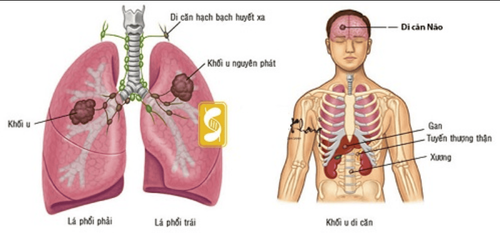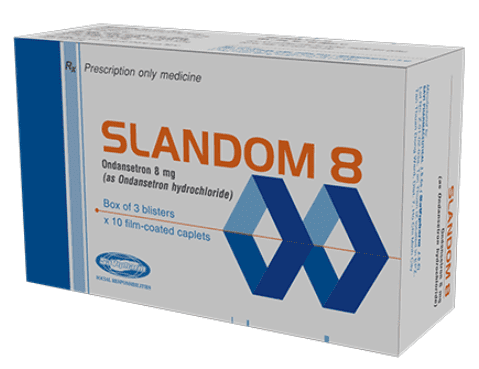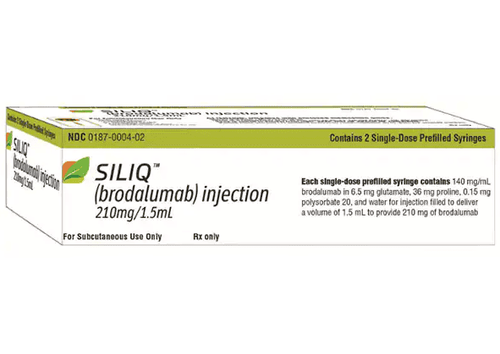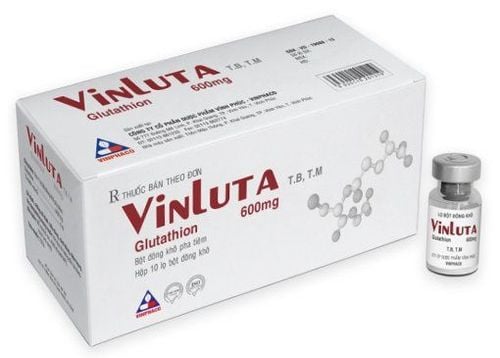This is an automatically translated article.
The article was professionally consulted by Dr. Le Tan Dat, Internal Medicine Oncologist, Radiation Therapy Center - Vinmec Central Park International General HospitalTargeted therapy, or more precisely, "molecular targeted therapy," is used to control cancer growth. They act on a specific molecular target inside or on the surface of cancer cells (genes or proteins). This helps to kill or slow down the growth of cancer cells, while minimizing damage to healthy cells.
1. Targeted therapy kills cancer cells
Most targeted therapies help treat cancer by interfering with proteins that cause tumors to grow and spread. They help treat cancer in a variety of ways:Help the immune system destroy cancer cells: One reason cancer cells thrive is because they can evade the immune system of body. Some targeted therapies can tag cancer cells so that it's easier for the immune system to find and destroy them. Other targeted therapies help boost the immune system to fight cancer cells. Prevents the growth of cancer cells: Healthy cells in the body only divide to make new cells when they receive a signal to do so. These signals bind to proteins on the cell surface, prompting cells to divide. This process helps new cells form when the body needs them. But, some cancer cells have protein changes on their surface that signal the cells to divide in an disordered way. Some targeted therapies interfere with these proteins, preventing them from stimulating cells to divide. This process helps to slow the uncontrolled growth of cancer cells. Prevents signals from forming blood vessels: Tumors need to form new blood vessels to grow larger. In a process called angiogenesis, these new blood vessels form in response to signals from the tumor. Angiogenesis inhibitors are a targeted therapy designed to interfere with these signals to help block the formation of a blood supply. Without a blood supply, the tumors remain small. Or, if the tumor already has a blood supply, this treatment can cause the blood vessels to die, causing the tumor to shrink. Delivers cancer-killing agents: Some monoclonal antibodies are combined with toxins, chemotherapy drugs, and radiation. Antibodies carry this cell-killing substance to the surface of cancer cells, causing them to absorb and then die. Unaffected cells will not be harmed. Cancer cell death: Healthy cells die in an orderly fashion when they are damaged or no longer needed. But, cancer cells have a way to avoid this dying process. Some targeted therapies can cause cancer cells to undergo cell death. Blocking supply of hormones needed for cancer cell growth: Certain diseases such as breast and prostate cancer require certain hormones to grow. Hormone therapy is a type of targeted therapy. It can work in two ways. Some hormone therapies stop the body from making specific hormones. Others help prevent hormones from affecting cells, including cancer cells.
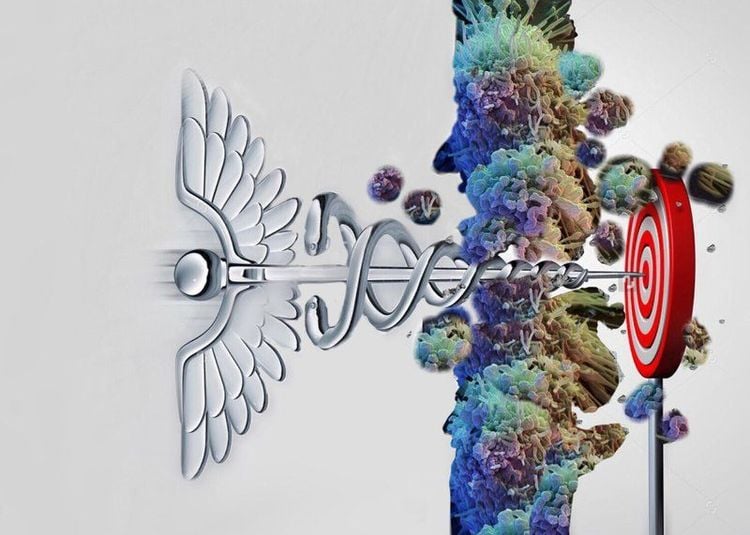
2. Classification of targeted therapy
Targeted therapy is the cornerstone of modern medicine. This is a type of treatment that targets changes in cancer cells that help them grow, divide, and spread. As researchers learn more about the cell changes that cause cancer, they can design therapies that target these changes or block their effects. The study of changes in cancer cells has helped scientists find a variety of therapies to slow their growth and destroy them. Most targeted therapies are prepared and administered as small molecule drugs or monoclonal antibodies. Small molecule drugs are small enough to enter cells easily, so they are used for targets located within the cell. Monoclonal antibodies (therapeutic antibodies) are proteins produced in a laboratory. These proteins are designed to attach to specific targets found on cancer cells. Some monoclonal antibodies mark cancer cells so that they are better seen and destroyed by the immune system. Other monoclonal antibodies directly stop cancer cells from growing or cause them to die on their own. The rest are antibodies that carry toxins to destroy cancer cells. This therapy has the disadvantage that it is difficult to penetrate cells. Instead, they attach to specific targets on the outer surface of cancer cells.Trắc nghiệm: Thử hiểu biết của bạn về bệnh ung thư
Ung thư là nguyên nhân gây tử vong hàng thứ 2 trên thế giới. Thử sức cùng bài trắc nghiệm sau đây sẽ giúp bạn có thêm kiến thức về yếu tố nguy cơ cũng như cách phòng ngừa bệnh ung thư.
Bài dịch từ: webmd.com
3. Subjects treated with targeted therapy
Different cancers have different characteristics of cancer cells. Therefore, depending on the type of cancer and the target to be targeted, there are different treatment methods. First, the tumor should be examined to see if it contains specific destructive features.The tumor will be examined by biopsy. A biopsy is a procedure in which a doctor removes a portion of a tumor for testing. There may be some risks with a biopsy. These risks vary depending on the size of the tumor and its location. Before deciding to have a biopsy, your doctor will explain the risks of the biopsy to you. Recently, a new advancement that is more convenient and less dangerous than direct biopsy of the tumor is the liquid biopsy: the genetic or histological features of the tumor are examined through testing from blood or body fluids, instead because it has to be biopsied from tumor tissue.

4. Disadvantages of Targeted Therapy
Targeted therapies have several disadvantages. These include:Resistance: Cancer cells can become resistant to drugs. For this reason, targeted therapies may work best only when used with other targeted therapies or in combination with other cancer treatments, such as chemotherapy and radiation. Causes side effects: The extent of side effects depends on the type of treatment and how the body reacts to it. The most common side effects include diarrhea and liver problems. Other possible side effects are blood clotting problems and delayed wound healing, high blood pressure, fatigue, mouth sores, nail changes, hair color loss, and skin problems (rash or dry skin). In addition, perforation of the esophagus, stomach, small intestine, large intestine, rectum or gallbladder, etc. has been reported, but rarely occurs.
Most of the side effects of targeted therapy go away after treatment ends.
5. What you need to know about the treatment process
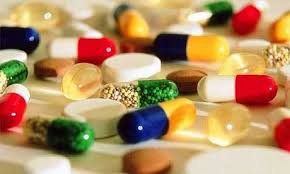
Patients can directly receive treatment at home or outpatient treatment at the hospital. This depends on the drug and how it is taken.
How often and when targeted therapy is received depends on:
The type of cancer and how advanced it is Type of targeted therapy The body's response to treatment Some targeted therapies are treated Cycle treatment (maybe every 2-3 weeks at a time). A cycle is the interval between treatment and rest. The rest period gives the patient's body a chance to recover and build new healthy cells.
Oncology - Radiation Center at Vinmec Times City International Hospital is one of the prestigious cancer treatment centers in Vietnam. The center is fully equipped with diagnostic facilities such as basic and advanced blood tests, blood tests - marrow histograms, tumor biopsies, histopathology, immunohistochemistry, molecular biology, etc. modern imaging system including PET/CT, SPECT/CT, MRI...,. Regarding treatment, at Vinmec health system, there are all forms of cancer treatment: Surgery, radiation therapy, chemotherapy, targeted therapy, immunotherapy, hematopoietic stem cell transplantation, ...
The treatment process is always closely coordinated with many specialties: Center for Diagnostic Imaging, Laboratory Testing, Cardiology, Stem Cells and Gene Technology; Department of Obstetrics and Gynecology, Department of Endocrinology, Department of Rehabilitation, Department of Psychology, Department of Nutrition.
Customers can go directly to Vinmec Times City to visit or contact hotline 0243 9743 556 for support.
Article referenced source: Cancer.gov
MORE:
What you need to know before deciding on cancer treatment Reproductive health care in female cancer patients Taking care of bone health in cancer patients letters






